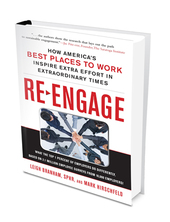
Re-Engage—what goes into employee engagement?
 Re-Engage: How America’s Best Places to Work Inspire Extra Effort in Extraordinary Times by Leigh Branham, SPHR and Mark Hirschfeld was published in early 2010. The book surveys over 10,000 employers in 43 states and found that the places people want to work are also the places where the most work is being done. The authors describe the innovative and real techniques being used by employers to keep their employees happy and engaged, and in the process, finding out it was well worth their while.
Re-Engage: How America’s Best Places to Work Inspire Extra Effort in Extraordinary Times by Leigh Branham, SPHR and Mark Hirschfeld was published in early 2010. The book surveys over 10,000 employers in 43 states and found that the places people want to work are also the places where the most work is being done. The authors describe the innovative and real techniques being used by employers to keep their employees happy and engaged, and in the process, finding out it was well worth their while.
We had the chance to talk to one of the authors, Mark Hirschfeld, about what he saw while he was researching and writing it. Here’s the conversation—including some great ideas and examples of how you can emulate these great places to work.
Of all the programs and incentives you heard about in your interviews, which stood out to you as the most innovative?
The thing that impresses me about highly engaged employers is how thorough and methodical they are in their efforts to create a great workplace. Truly, nothing seems left to chance. In that sense, their success is not tied necessarily to any one program but to a culture that values and engages employees in every way possible, from how employees are led to how they are compensated to how their career aspirations are supported. We were in awe of the lengths that many of these companies go to support their employees, but when you see the business results they are achieving it’s also clear the effort brings significant rewards. In our book we highlight the six areas that tends to drive increased engagement, from the importance of an involved leadership to a commitment to employee health and well being.
We note that the best employers seem to take engagement to a point where they put their own “signature” on their actions, so the programs or policies or initiatives fit and reflect their culture. For example, Rackspace Hosting of San Antonio, Texas has created a culture around what they call “fanatical service,” which has helped them grow in leaps and bounds through a very loyal, engaged workforce. They give employees, whom they call “rackers,” great leeway in making decisions they think are in the best interests of providing fanatical service to their customers, and their training and development to support this level of empowerment is extensive and ongoing. Their approach to employee engagement and using a novel name for their employees may not fit every culture, but it works marvelously for them.
What do you see as the one or two steps any employer could easily implement that would significantly benefit their employee engagement?
First, listen intently and deeply to your associates about what would be helpful to them in creating a more engaged place to work; and second, make sure you follow up on anything you commit to do. We’re amazed how much employees appreciate truly being “heard,” and leaders we talk to are equally pleased at how much they learn when they actually take the time to listen. Take opportunities to get feedback often. To be sure, most fair-minded employees understand that leaders can’t take action on everything they suggest, but they do want to have a sense that their opinions matter. The ability to feel genuinely heard can be very empowering, and if employees see actions being taken based on their feedback significant growth can result.
The two steps are really quite straightforward, but the work is in the implementation. As Peter Drucker said: “Every good idea sooner or later degenerates down to hard work,” and if leaders are willing to do the hard work good things can happen. Our research shows that if employees feel like their managers are following up they are six times more likely to believe meaningful change can happen. If I were a leader of a company I would want to have those odds on my side, so I’d make sure my entire management team was committed to following up.
Employee benefits have only recently been seen as a factor in employee engagement. What will be the effect as more Gen Xers and Millennials enter the workforce?
Our research shows that as companies become more age diverse employee engagement can suffer, so we’re going to need to work even harder to maintain a great place to work as our workforce becomes more generationally diverse. I think the days of “one-size-fits-all” for employee benefits needs go the way of the buggy whip. In the future we’re going to need to be even smarter about offering a range of benefits that meets the different needs of our employees, and taking generational diversity into consideration is but one important factor.
Have you seen a specific program or initiative that has had more impact on engagement than others?
One of the comments that really struck us that an employee made about the poor leadership exhibited where she works: “the fish rots from the head down”…ouch! But the comment highlights the most important ingredient in create a great workplace—senior leader commitment.
It’s been our experience that the degree to which the senior leadership of an organization is committed to creating and maintaining an engaging workplace makes all the difference. Sure, one manager may be able to impact her work group or territory in the absence of senior leadership support, but for engagement to change across an enterprise the entire senior leadership team—not just the HR leadership—has to be on board. Employees will take this stuff seriously only to the degree they see top leaders making a commitment.
By way of example, just yesterday I was providing feedback to a client about the results of focus groups we conducted around the topic of employee engagement and wellness. We reported that many associates noted how positive it was when they see top executives in the corporate gym sweating away with fellow employees. This was one of many actions where employees saw the leadership “walking the talk” and, as a result, engagement was trending upward.
Some of the early research in the area of employee engagement reported the significant impact that a direct supervisor has on employee engagement, and our studies certainly echo that. But what is now clear is that top leadership has as important a role. They cannot fiat this away as “engagement is just an HR program”—they need to sincerely and passionately get in the game.
At the end of chapter 9, you mention an employer considering the option of stopping payment for certain medications if employees don’t make reasonable lifestyle changes that are funded and supported by the employer. What do you think the likelihood is that this will become a normal practice within the next 5-10 years?
We have to create greater collaboration around this issue. As employers we’ve paid claims for all health conditions, including those that are greatly influenced by poor lifestyle choices—that can’t continue. At SilverStone Group where I work we offer a significant reduction in the monthly health insurance premium if employees are actively involved in our corporate wellness effort, and we’re seeing a terrific ROI. I think we’ll get much smarter about putting together better partnerships with our employees where we offer the resources they can access that help them make better lifestyle choices and, in doing so, become healthier and more productive. And there will also need to be more accountability on the part of employees to take better care of themselves. In the end this is good for everyone.
You mention two divergent mindsets to dealing with the health and well-being of employees and that winning employers tend to favor being more actively involved. What will it take for those choosing to distance themselves to change their mindset?
I think many employers are finally seeing the cost-benefit to creating a more engaging work culture, one that increases per person productivity and creates a healthier workforce. One of the companies we highlight in the book, Greater Omaha Packing, enjoys greater productivity and minimal annual health insurance premium increases because of their commitment to an engaging culture that emphasizes. Bottom line, creating a great workplace directly impacts the bottom line!
Want to hear more from Mark? You can follow him on Twitter @MDHirschfeld
Work with Us
We partner with organizations that value their people first. Let’s talk.

Jennifer Benz, SVP Communications Leader, has been on the leading edge of employee benefits for more than 20 years and is an influential voice in the employee benefits industry.
